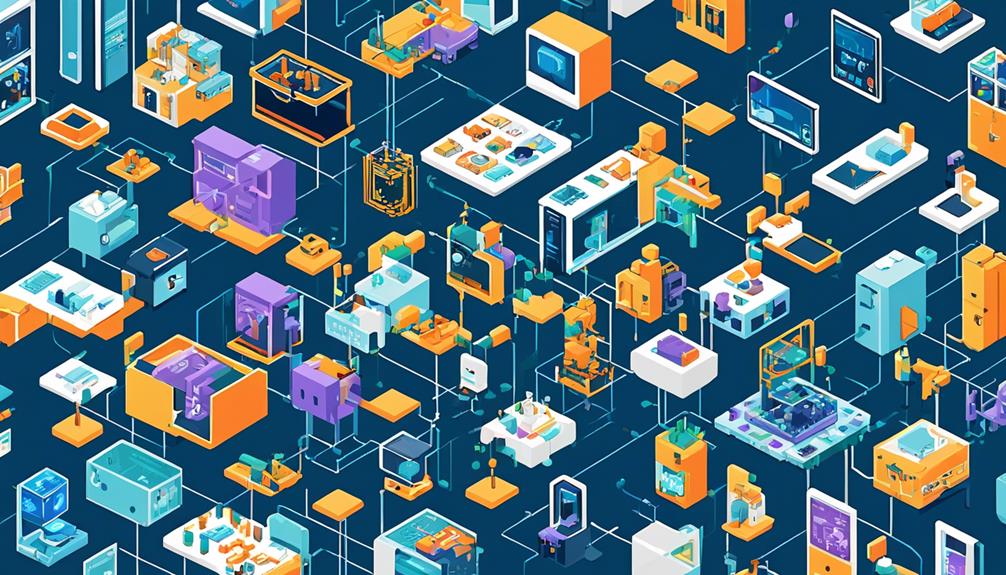Edge computing has emerged as a promising solution to address the challenges posed by the exponential growth of IoT devices and their data.
However, with this new paradigm comes a set of unique challenges that need to be overcome for the successful implementation of edge computing in IoT environments. From hardware integration and scalability to data security and real-time processing, various aspects demand careful consideration.
In this discussion, we will explore these challenges and delve into the solutions that researchers and practitioners have proposed to tackle them. By understanding the intricacies of edge computing for IoT, we can unlock its full potential and pave the way for a more efficient and robust IoT ecosystem.
Key Takeaways
- Standardized communication protocols are crucial for seamless data exchange at the edge.
- Balancing computational tasks and resource allocation is essential for optimizing performance in edge computing systems.
- Connectivity and network bandwidth limitations pose challenges that can be addressed through network optimization techniques.
- Encryption techniques and secure data transmission protocols are necessary for maintaining data security in edge computing environments.
Hardware Integration Challenges
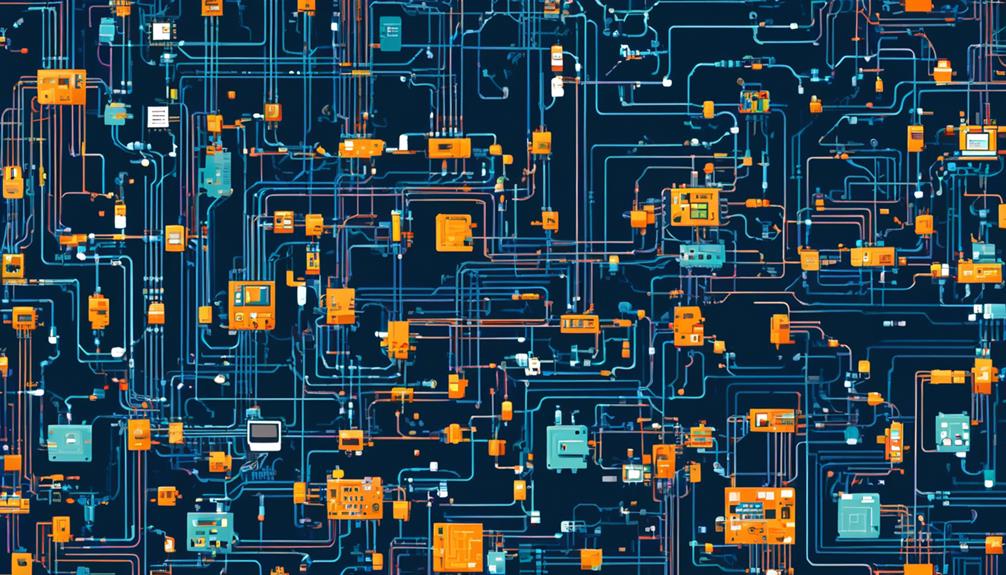
The integration of hardware devices with edge computing systems presents significant challenges in compatibility and interfacing. As edge computing becomes increasingly popular in the context of IoT devices, the need for efficient and seamless hardware integration becomes crucial.
One of the main hardware integration challenges is ensuring standardized communication protocols across diverse devices. With the vast array of IoT devices available, each with its own communication protocols, it becomes essential to establish a common framework for seamless data exchange at the edge. Compatibility issues also arise when integrating legacy hardware with modern edge computing solutions. Legacy hardware may lack the necessary capabilities and interfaces to effectively communicate with the edge computing systems. This requires careful consideration and potentially the use of adapters or gateways to bridge the gap between old and new technologies.
Interfacing different hardware components also poses a challenge in hardware integration for edge computing. System architects and hardware designers need to have a deep understanding of the various hardware components and their interconnections. This includes considerations for power consumption, cooling mechanisms, and physical space constraints. Edge computing deployments often involve limited physical space and may require the use of compact and energy-efficient hardware devices.
To address these challenges, research and innovation are essential. Standardization efforts are needed to establish common communication protocols and ensure compatibility between devices. Additionally, advancements in hardware design and system architecture will help streamline the integration process. Collaborative efforts between hardware manufacturers, software developers, and edge computing specialists will play a crucial role in overcoming these hardware integration challenges in the context of edge computing for IoT.
Scalability and Resource Constraints
To ensure optimal performance and accommodate growing demands in edge computing systems, managing scalability and addressing resource constraints are critical considerations.
Edge computing faces challenges in terms of scalability due to the increasing number of connected devices and the exponential growth of data generated by the Internet of Things (IoT). Resource constraints pose another significant challenge, as edge devices often have limited processing power, memory, and storage capabilities.
Scalability in edge computing refers to the ability of the system to handle increasing workloads and accommodate a growing number of devices. As the number of IoT devices continues to rise, edge computing systems must be able to scale both horizontally and vertically. Horizontal scalability involves adding more edge devices to distribute the workload, while vertical scalability involves increasing the resources of individual edge devices. Balancing computational tasks and resource allocation is crucial to optimize performance and prevent overload in edge computing environments.
Resource constraints in edge computing pose a challenge in efficiently utilizing limited resources. Edge devices have limited processing power, memory, and storage, which can restrict the complexity and size of the computational tasks they can handle. To overcome these constraints, potential solutions include offloading computational tasks to the cloud or other edge devices with more resources, implementing task scheduling algorithms to optimize resource allocation, and utilizing compression techniques to reduce the size of data transmitted between edge devices and the cloud.
In addition, enhancing energy efficiency is crucial in edge computing systems to optimize resource utilization. Techniques such as dynamic voltage and frequency scaling (DVFS) can be employed to adjust the power consumption of edge devices based on workload requirements. Furthermore, edge devices can be designed to minimize energy consumption by utilizing low-power processors and optimizing communication protocols.
Connectivity and Network Bandwidth Limitations

Connectivity and network bandwidth limitations pose significant challenges to the effective implementation of edge computing for IoT. The increasing demand for bandwidth and the need for reliable network coverage require innovative solutions.
Addressing these challenges involves finding ways to optimize network resources, such as implementing control delivery networks and breaking down edge servers into multiple routes.
Network Coverage Challenges
Network coverage challenges in edge computing, specifically related to connectivity and network bandwidth limitations, present significant obstacles to maintaining a stable and efficient connection between edge devices and central data centers. These challenges can result in data transmission issues and impact the overall performance of edge computing systems. Traditional networks tend to allocate higher bandwidth to central data centers, leaving lower bandwidth for endpoints, which hampers the capabilities of edge devices. To address these challenges, innovative solutions are being developed. For instance, China United Network Communications has filed a patent for a Control Delivery Network (CDN) to cope with bandwidth limitations in edge computing. Samsung, on the other hand, has filed a patent for analyzing network architecture to determine expected latency and optimize the edge transfer process, thus addressing network coverage challenges.
| Challenge | Impact | Solution |
|---|---|---|
| Connectivity limitations | Unstable connection between edge devices and central data centers | Control Delivery Network (CDN) |
| Network bandwidth limitations | Data transmission issues and inefficiency | Analyzing network architecture to optimize edge transfer process |
Bandwidth Constraints
Bandwidth constraints in edge computing systems pose challenges for data transmission and efficient utilization of available network bandwidth. With the rapid growth of the Internet of Things (IoT) and the increasing number of edge devices, the demand for bandwidth has escalated significantly. However, limited bandwidth can result in communication delays and reduced data transfer speeds, compromising the real-time processing and responsiveness of edge computing systems.
To overcome these challenges, optimizing data transmission and prioritizing critical data become essential. Compression techniques and efficient data caching strategies at the edge can be leveraged to address bandwidth limitations.
Additionally, implementing network bandwidth management solutions can help mitigate the impact of bandwidth constraints on edge computing operations.
As the demand for edge computing continues to rise, addressing bandwidth requirements will be crucial for ensuring the seamless functioning of IoT applications.
Connectivity Solutions
Are there effective approaches to overcome the challenges posed by limited network resources in edge computing systems? Connectivity solutions play a crucial role in addressing the connectivity and network bandwidth limitations in edge computing technology. Here are some innovative solutions that have been proposed:
- Control Delivery Network (CDN): China United Network Communications suggests using a CDN to manage bandwidth issues by assigning a fixed threshold value to each edge server.
- Distributed Computing: Beijing Zhixin Microelectronics Technology breaks down the edge server into multiple routes and dynamically forms new routes to meet the requirements of distributed edge nodes.
- Network Architecture Optimization: Samsung analyzes network architecture to optimize the edge transfer process based on expected latency, reducing lags in data processing.
- Security and Encryption: Zhejiang Geely Group proposes a blockchain-based security encryption method that utilizes multi-level verification, encryption, and blockchain authentication.
These solutions aim to enhance connectivity, improve network bandwidth utilization, and ensure secure and efficient transmission of IoT data in edge computing systems.
Data Security and Encryption
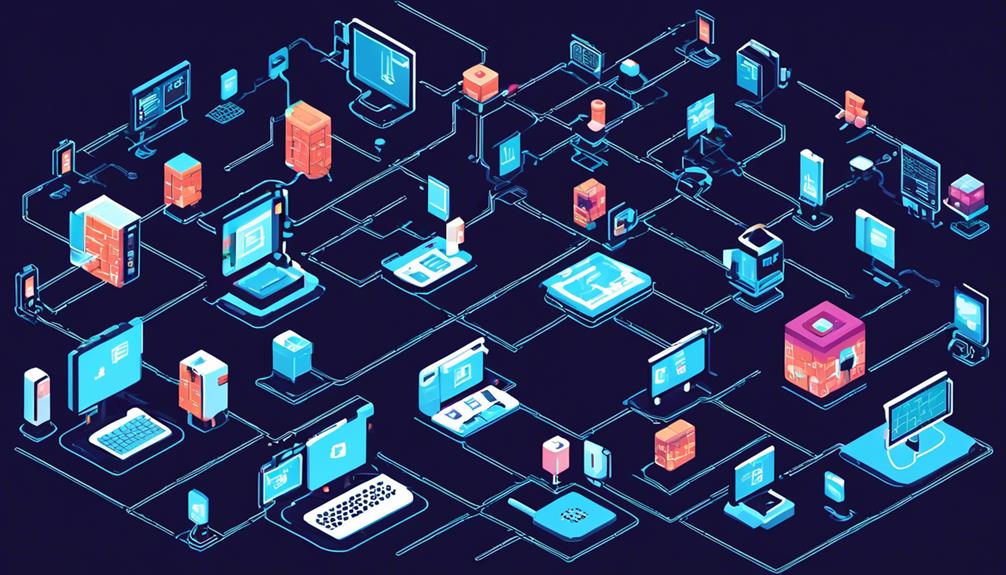
Data security and encryption are critical aspects of edge computing for IoT.
Encryption techniques play a key role in protecting sensitive data by converting it into an unreadable code, ensuring that only authorized parties can decipher it.
Additionally, secure data transmission protocols and privacy concerns and compliance measures are essential for maintaining the confidentiality and integrity of data in edge computing environments.
Encryption Techniques for Data
What are the key encryption techniques used to ensure the confidentiality and integrity of data in transit and at rest?
- Symmetric key encryption: This technique uses a single key to both encrypt and decrypt data, ensuring secure transmission and storage within the edge computing environment of the IoT ecosystem.
- Asymmetric key encryption: This method utilizes a pair of keys, a public key for encryption and a private key for decryption. It provides a higher level of security by enabling secure communication between multiple devices within the IoT ecosystem.
- Homomorphic encryption: This encryption technique allows computation on encrypted data without the need for decryption, thereby preserving privacy and security.
- End-to-end encryption: This approach secures data from the source to the destination, preventing unauthorized access or interception during transit.
- Quantum-resistant encryption: With the emergence of quantum computing, encryption methods are being developed to safeguard against potential future threats, ensuring long-term data security within the edge computing and IoT ecosystem.
These encryption techniques play a crucial role in implementing robust security measures for data in transit and at rest within the edge computing environment of the IoT ecosystem.
Secure Data Transmission
Secure data transmission is a critical aspect of ensuring the confidentiality, integrity, and privacy of sensitive information during its transfer. In the context of edge computing and IoT, where data is generated by numerous sensors and devices, the need for secure data transmission becomes even more crucial. To address the security challenges associated with data transmission, various encryption techniques are employed. These techniques encode the data, preventing unauthorized access and ensuring privacy. End-to-end encryption is a common approach, ensuring that data remains encrypted throughout its journey. Additionally, techniques such as SSL/TLS protocols and VPNs are used to establish secure connections for transmitting data. By implementing these security measures, organizations can prevent data breaches and maintain the integrity of transferred data.
| Encryption Techniques | Advantages | Disadvantages |
|---|---|---|
| Symmetric Encryption | – Fast and efficient encryption.<br>- Suitable for large data transfers. | – Requires a secure method for key exchange.<br>- Not suitable for scenarios where data needs to be shared with multiple parties. |
| Asymmetric Encryption | – Provides secure key exchange without requiring a prior secure channel.<br>- Suitable for scenarios where data needs to be shared with multiple parties. | – Slower compared to symmetric encryption.<br>- Requires more computational resources. |
| Hash Functions | – Provides data integrity verification.<br>- Efficient and fast. | – Cannot be reversed to retrieve original data.<br>- Vulnerable to collision attacks. |
Table: Comparison of Encryption Techniques for Secure Data Transmission.
Privacy Concerns and Compliance
Privacy concerns and compliance with data security regulations are paramount when addressing the challenges of data security and encryption in IoT edge computing. To ensure the security and privacy of data in edge computing environments, the following measures must be taken:
- Encryption of data transmission and storage: Implementing strong encryption algorithms helps protect sensitive information from unauthorized access and data breaches.
- Robust security measures: Deploying firewalls, intrusion detection systems, and access controls helps safeguard against potential threats and malicious activities.
- Privacy risk mitigation: Adhering to data security best practices, such as regularly updating software and conducting security audits, helps mitigate privacy risks.
- Regulatory compliance: Compliance with data security regulations, such as GDPR and CCPA, is essential to protect user information and avoid legal consequences.
- User awareness and consent: Educating users about the privacy implications of edge computing and obtaining their informed consent is crucial for maintaining transparency and trust.
Latency and Real-Time Processing
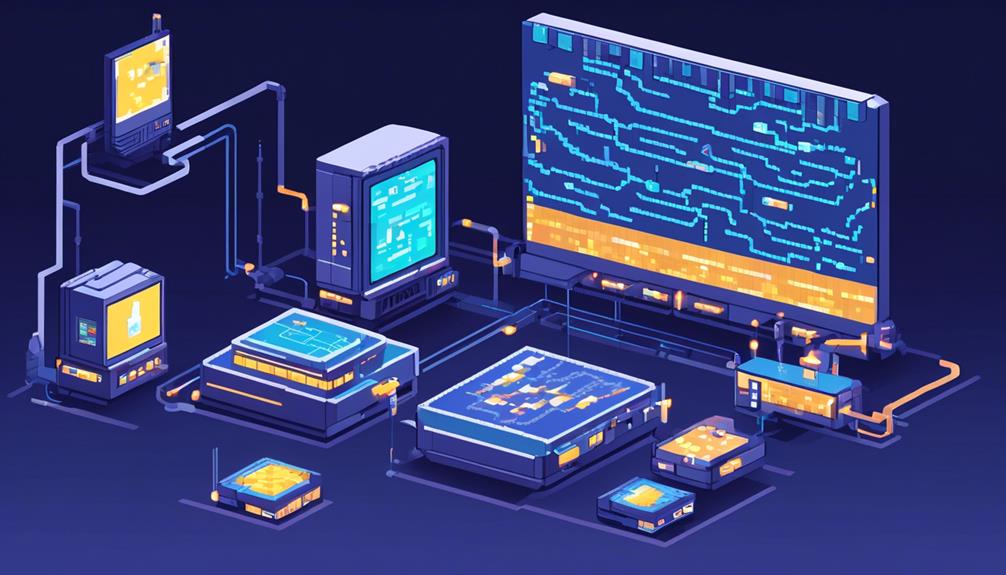
Latency poses a significant challenge in edge computing for IoT, particularly in real-time processing. The delay in data transmission within an edge server can have a significant impact on the ability to analyze and respond to data in real-time. Real-time processing solutions aim to minimize latency to enable immediate data analysis and response.
To address latency challenges in edge computing for IoT, several strategies can be employed. One approach is to analyze the network architecture to identify potential areas of latency and optimize data transmission paths. By reducing data transmission delays, the overall latency can be minimized.
Another solution is the proximity placement of edge devices. By placing edge devices closer to the data source or the end-user, the distance and time required for data transmission can be reduced, thereby decreasing latency. Utilizing content delivery networks (CDNs) can also help reduce latency by caching data closer to the end-users.
Furthermore, reducing reliance on centralized servers can mitigate latency issues. Distributing computational tasks across edge devices can help alleviate the burden on centralized servers, reducing the overall latency in real-time processing.
In addition, implementing lightweight algorithms and prioritizing data can help overcome the limited computational resources often encountered in edge computing. By optimizing the use of available resources, latency can be reduced, enabling more efficient real-time processing.
Power Consumption and Energy Efficiency
In the realm of edge computing for IoT, power consumption and energy efficiency emerge as crucial concerns, given the reliance on distributed and remote computing nodes. As edge computing continues to gain momentum, it becomes imperative to address the challenges associated with power consumption to ensure sustainable and efficient deployment of edge computing infrastructure.
Here are some key considerations for optimizing power consumption and improving energy efficiency in edge computing systems:
- Optimizing hardware and software: Fine-tuning both hardware and software components is essential to minimize power usage in edge computing devices. This includes selecting low-power processors, energy-efficient networking components, and implementing power management techniques at the hardware and software level.
- Energy-efficient networking: The networking infrastructure plays a vital role in power consumption within edge computing systems. By using energy-efficient networking protocols and optimizing network configurations, it is possible to reduce power consumption and enhance energy efficiency.
- Renewable energy sources: Leveraging renewable energy sources, such as solar or wind power, can significantly contribute to sustainable power solutions for edge computing deployments. By harnessing clean and renewable energy, the environmental impact of edge computing systems can be minimized.
- Energy harvesting technologies: Energy harvesting technologies, such as solar panels or kinetic energy converters, can be integrated into edge computing devices to harvest and store energy from the surrounding environment. This enables the devices to operate autonomously and reduce their reliance on traditional power sources.
- Energy efficiency monitoring and management: Implementing energy efficiency monitoring and management systems can provide real-time insights into power consumption patterns and enable proactive measures to optimize energy usage. This includes dynamically adjusting power allocation based on workload demands and identifying energy-intensive processes for optimization.
Edge Device Management and Maintenance
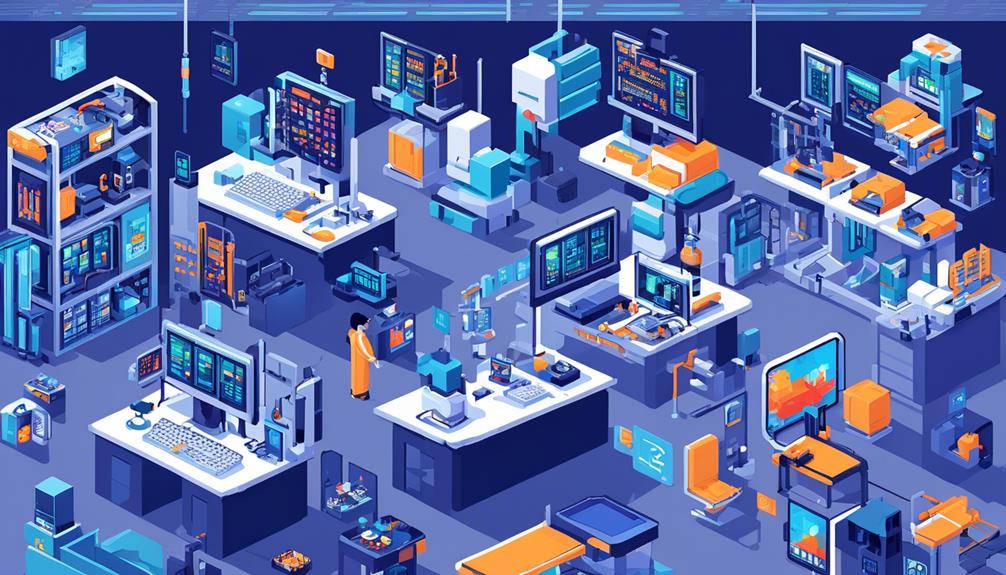
Edge device management and maintenance is a critical aspect of edge computing that involves deploying and maintaining computational tasks near end devices. With the increasing adoption of edge computing, the volume of data generated by edge devices has grown exponentially. This presents challenges in effectively managing and maintaining these devices.
One of the major challenges in edge device management is the operational constraints faced by these devices. Edge devices, such as sensors and actuators, often have limited computational resources, storage capacity, and battery life. This makes it crucial to optimize the deployment of computational tasks and ensure efficient resource utilization.
Communication issues between edge devices also pose a challenge in device management. Edge devices are often geographically dispersed and may have intermittent connectivity. This can hinder the timely transfer of data and the execution of computational tasks. Addressing these communication issues requires robust networking protocols and reliable connectivity solutions.
To overcome these challenges, several solutions have been proposed. Leveraging mobile devices for edge computing can help mitigate resource constraints by offloading computational tasks to more powerful devices. Using lightweight algorithms can reduce the computational burden on edge devices while still achieving the desired functionality. Additionally, optimizing data distribution closer to edge devices using content delivery networks (CDNs) can improve data transfer efficiency.
Security concerns are also a crucial aspect of edge device management. End-to-end encryption, monitoring networks for malicious activities, and analyzing firmware and software before execution are some measures that can be implemented to ensure the security of edge devices and the data they generate.
Efficient data management and storage are essential in edge device management. Categorizing data based on importance and access frequency can help prioritize storage and retrieval. Storing frequently accessed data at the edge can reduce retrieval time and improve overall system performance.
Data Accumulation and Storage
Data accumulation and storage play a crucial role in the transition from local to virtualized storage options, impacting both IoT and Cloud computing ecosystems. With the emergence of edge computing, data storage has become a key consideration in optimizing the performance and efficiency of IoT systems.
Here are some important facts to consider:
- Simplified management: Edge computing allows for data accumulation and storage closer to the source, reducing the need for extensive centralized infrastructure. This simplifies data management and enables efficient data processing.
- Universal availability: By storing data at the edge, it becomes readily available to local devices and applications, reducing the latency associated with retrieving data from distant cloud servers. This improves real-time decision-making capabilities.
- Decreased hardware requirements: Edge computing reduces the reliance on traditional data centers by distributing computational tasks to edge nodes. This results in decreased hardware requirements for data storage, leading to cost savings and improved scalability.
- Communication latency: Edge data centers enable faster data processing and analysis by bringing computational resources closer to the devices generating the data. This reduces communication latency and enables real-time responses.
- Resource investment and management: Edge computing introduces challenges in managing and maintaining distributed edge nodes across multiple remote locations. Efficient allocation and management of resources are necessary to ensure optimal performance and minimize operational costs.
Unified Architecture and Release Processes
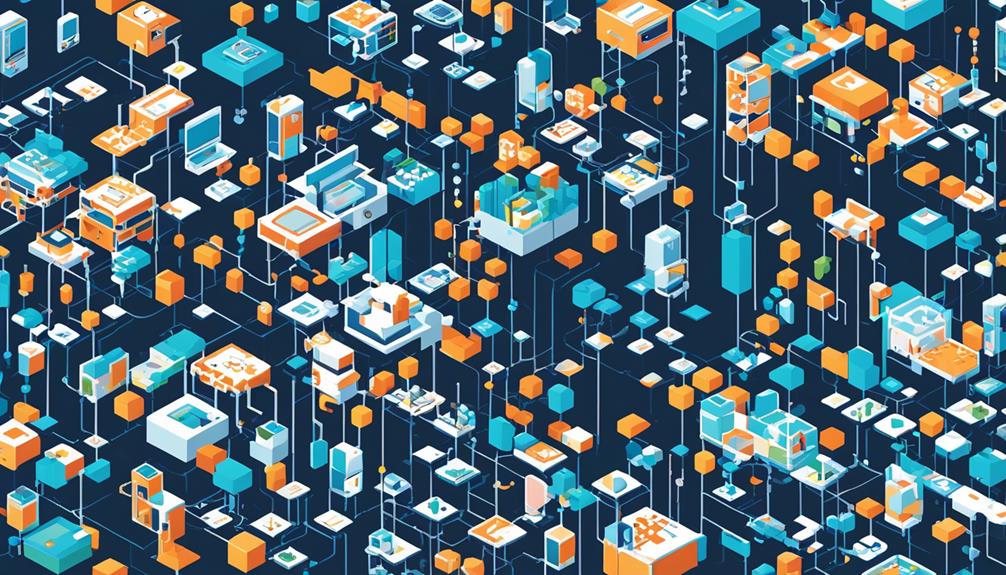
With the increasing adoption of edge computing in IoT systems, the focus now shifts to the unified architecture and release processes that streamline development and ensure consistency across these distributed computing environments. Edge computing brings computing capabilities closer to the data source, enabling real-time processing and analysis. However, managing and scaling edge computing solutions can be challenging due to the distributed nature of these systems.
One of the main challenges in edge computing is preventing unauthorized access to the devices and data at the edge. With data being generated and processed at various edge locations, it is crucial to have a unified architecture that provides a standardized and secure framework for deploying and managing edge computing systems. A unified architecture reduces complexity and enhances interoperability by defining common protocols, interfaces, and data formats.
Furthermore, consistent release processes are essential to ensure that updates and enhancements are efficiently deployed across the edge computing infrastructure. By adopting a standardized approach to releasing software and firmware updates, organizations can maintain the integrity of their edge computing systems and quickly address any security vulnerabilities or performance issues. This also facilitates the seamless integration of new features and improvements in edge computing systems.
To implement a unified architecture and streamline release processes, organizations need to establish clear guidelines and standards for edge computing development. This includes defining common APIs, data models, and security protocols to ensure interoperability and prevent fragmentation in the ecosystem. Additionally, organizations should invest in robust testing and validation frameworks to verify the compatibility and functionality of software and firmware updates before deployment.
Frequently Asked Questions
What Are the Challenges of Edge Computing in Iot?
Challenges of edge computing in IoT include:
- Scalability: As the number of IoT devices and data volumes increase, ensuring that edge computing can handle the growing demand becomes a concern.
- Security: Protecting sensitive data transmitted between devices and the edge is essential to prevent unauthorized access and maintain the privacy of users.
- Latency reduction: Enabling real-time decision-making and minimizing delays in critical applications is crucial, as latency can impact the effectiveness and efficiency of IoT systems.
Additionally, there is the challenge of ensuring efficient data management and communication between diverse edge devices.
Addressing these challenges is vital for the successful implementation of edge computing in IoT systems.
What Problems Does Edge Computing Solve?
Edge computing solves several problems in IoT.
It reduces communication latency by deploying computational tasks to computing nodes near end devices. This improves application response times and overall system performance.
It also addresses the vulnerability of IoT services to network problems by leveraging 5G technology for improved last-mile connection performance.
Edge computing helps in reducing security risks associated with data transfers by storing data locally, facilitating regulatory compliance.
Additionally, it saves money by optimizing data processing, reducing network bandwidth requirements, and cloud storage capacity.
How Edge Computing Is Useful in Iot?
Edge computing is a crucial component in the IoT ecosystem, providing numerous benefits and applications. By processing and analyzing data at the edge, closer to where it is generated, edge computing significantly reduces latency and improves application response times.
This architecture also optimizes the data processing process by offloading computational tasks to computing nodes near end devices. The benefits of edge computing in IoT include reduced network bandwidth requirements, cost-effective deployments, regulatory compliance, and enhanced security by storing data locally.
Various use cases, such as smart cities, autonomous vehicles, and industrial automation, further highlight the usefulness of edge computing in IoT.
What Are the Weaknesses of Edge Computing?
Weaknesses of edge computing include:
- Security concerns, which arise due to vulnerabilities to cyber threats and weak authentication methods.
- Scalability issues, which arise from the need for investments in edge resources, such as powerful servers, storage, and power and cooling resources.
- Latency challenges, which arise from poor performance caused by data latency due to local network conditions causing congestion and interference.
These weaknesses need to be addressed to fully leverage the benefits of edge computing in IoT applications.
